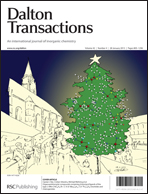V6O13 films by control of the oxidation state from aqueous precursor to crystalline phase†
Abstract
An aqueous deposition process for V6O13 films is developed whereby the vanadium oxidation state is continuously controlled throughout the entire process. In the precursor stage, a controlled wet chemical reduction of the vanadium(V) source with oxalic acid is achieved and monitored by 51Vanadium Nuclear Magnetic Resonance (51V-NMR) and Ultraviolet-Visible (UV-Vis) spectroscopy. The resulting vanadium(IV) species in the aqueous solution are identified as mononuclear citrato-oxovanadate(IV) complexes by Electron Paramagnetic Resonance (EPR) and Fourier Transform Infra-Red (FTIR) spectroscopy. This precursor is successfully employed for the deposition of uniform, thin films. The optimal deposition and annealing conditions for the formation of crystalline V6O13, including the control of the vanadium oxidation state, are determined through an elaborate study of processing temperature and O2 partial pressure. To ensure a sub 100 nm adjustable film thickness, a non-oxidative intermediate thermal treatment is carried out at the end of each deposition cycle, allowing maximal precursor decomposition while still avoiding V(IV) oxidation. The resulting surface hydrophilicity, indispensable for the homogeneous deposition of the next layer, is explained by an increased surface roughness and the increased availability of surface vanadyl groups. Crystalline V6O13 with a preferential (002) orientation is obtained after a post deposition annealing in a 0.1% O2 ambient for thin films with a thickness of 20 nm.


 Please wait while we load your content...
Please wait while we load your content...